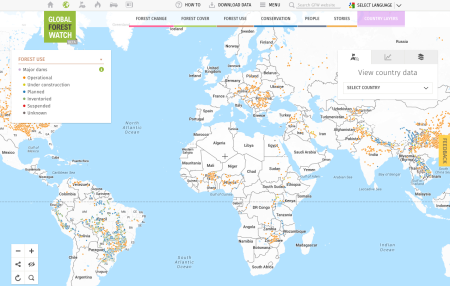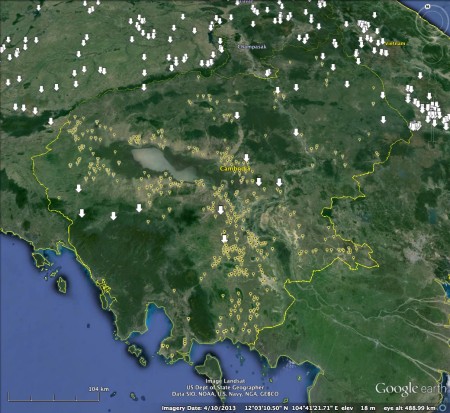- China’s crop wild relatives: Diversity for agriculture and food security. 871 wild species related to crops important in China, some of them endemic and endangered.
- Black-bone goat: An investigation report on new genetic resource of farm animal. Out of China…
- Effects of agricultural biodiversity and seasonal rain on dietary adequacy and household food security in rural areas of Kenya. More dietary diversity is better for your kids’ nutrition, and so is rain.
- Farmers’ rice knowledge and adoption of new cultivars in the Tillabéry region of western Niger. The landrace is hippopotamus-resistant.
- An invasive non-native mammal population conserves genetic diversity lost from its native range. Same for some crop wild relatives?
- Diversifying mechanisms in the on-farm evolution of crop mixtures. Diversity within mixture of 4 French wheat landraces changes in different ways in different places.
- The Role of Local Sheep and Goat Breeds and Their Products as a Tool for Sustainability and Safeguard of the Mediterranean Environment. Cheese made from local breeds is better. Well, at least different.
- Saving seeds: The Svalbard Global Seed Vault, Native American seed savers, and problems of property. “…the Svalbard Global Seed Vault is unique in its potential ability to cross the political and cultural divide over the ownership and conservation of seeds and thereby promote the vital ecological need for both ex situ and in situ seed preservation.”
- Genetic Diversity among Wheat Accessions from the USDA National Small Grains Collection. Geography is a good basis on which to base a core collection.
- Food sovereignty, food security and fair trade: the case of an influential Nicaraguan smallholder cooperative. They can all be integrated, but food security is the difficult one.
- Maize migration: key crop expands to higher altitudes under climate change in the Andes. 10m a year.
Dam the genetic resources, full speed ahead
Global Forest Watch now has a dam dataset, covering 50 major river basins. Here’s what it looks like:

You can mash it up online with various forest datasets, but you can also download it as a kml. Which of course means you can mash it up with your own dataset. That’s what I’ve done here with wild rice from Cambodia. The white arrows are dams, most of them either planned or under construction, the yellow dots samples of wild Oryza according to Genesys.

You’ll notice a few dams with few or no nearby specimens. Off the top of my head, those would seem to be places where collecting might be in order, before the disruption goes too far. But what do the rice experts out there think?
LATER: Seems I might be on to something…
@AgroBioDiverse @RiceResearch @BrianFLloyd And not just rice of course. Yes, I would expect a serious consequence.
— Mike Jackson OBE (@mikejackson1948) May 5, 2015
Nibbles: Forced exercise, Monoculture, Nutrition, Afghan poppies, USDA pears
- Get fit, before you visit Expo 2015 in Milan.
- Monoculture has a good side? Say it isn’t so!
- Too busy farming to cook nutritious meals.
- Another triumph for crop improvement.
- Genebank goes pear-shaped.
Brainfood: Tomato diversity, Tomato characterization, Sweetpotato diversity, Olive characterization, Bamboo as fodder, Chinese liquor, Agroecological livestock, Oasis agrobiodiversity, Pearl millet diversity double
- Genomic variation in tomato, from wild ancestors to contemporary breeding accessions. A first domestication in South America, a second step in Mesoamerica, occasional hybridization in the wild, differentiation through human selection. Some Ecuadorian and Peruvian diversity still unexplored for breeding.
- Characterization of a collection of local varieties of tomato (Solanum lycopersicum L.) using conventional descriptors and the high-throughput phenomics tool Tomato Analyzer. Instant gratification comes to tomato characterization.
- Molecular diversity and genetic structure of 380 sweetpotato accessions as revealed by SSR markers. Also a two-step domestication history? What are the odds?
- Association of SSR markers with contents of fatty acids in olive oil and genetic diversity analysis of an olive core collection. Let the molecular-assisted breeding begin.
- Genetic Evaluation of Nutritional and Fodder Quality of Different Bamboo Species. Remarkably, some species are ok.
- Genetic Diversity Among the Microorganisms in Daqu Used for Beidacang Liquor as Revealed by RAPD Analyses. Well that’s a new one on me, but it’s good to have the data.
- Farm animal genetic and genomic resources from an agroecological perspective. If you’re going to really be ecological in your management of livestock genetic resources, you need to factor in ecosystem services, and figure out how genomic tools are going to help you. Well, that pretty much goes for crops too, surely.
- The labor of agrodiversity in a Moroccan oasis. Not all agrobiodiversity is that old.
- Identification of pearl millet (Pennisetum glaucum (L.) R. Br.) germplasm with unique popping quality in the national genebank collections of India. Amazing what you can find in genebanks.
- Iniadi pearl millet germplasm as a valuable genetic resource for high grain iron. See what I mean?
Spreading the good genebank news
As I suspected, that “genebanks as morgues” slide that was shown yesterday at the Monogram 2015 meeting at Rothamstead, ((“The Monogram Network meeting is the annual get together for the small-grain cereal and grass research community. Academics, commercial scientists and plant breeders meet to hear about the latest advances, exchange ideas and discuss collaboration.”)) and was tweeted at the time, was but a rhetorical gambit, a way of framing an argument to the opposite effect. That argument was that thanks to recent advances in genomics and bioinformatics, genebanks are in fact alive and kicking, and more used — and useful — than ever. As indeed is being shown by the subject of the presentation in question, the Seeds of Discovery project at CIMMYT. I’m glad that’s settled.
But it is interesting to ponder the power — and danger — of rhetorical devices, in an era of 140-character textbites. I mean, it’s a perfectly valid strategy in a fifteen-minute presentation to develop the argument that genebanks are being assiduously mined by breeders for all kinds of useful alleles by opening with the admittedly occasionally-voiced accusation that they are nothing but museums — or worse, morgues. I confess I may well have used such a strategy myself, on occasion. It is a potent way of getting the audience’s attention.
But you do need those subsequent fourteen minutes to make the case, and those in your audience who are so inclined may well remember, and repeat, the accusation more readily and forcefully than the clinching counter-argument. Some, indeed, may start to wonder whether genebanks were basically moribund in the past, and have been brought back from the brink by things like high-throughput genotyping and the associated bioinformatics. Gene-jockeys to the rescue! Whereas in fact breeders have been using genebanks since they began, just in different ways, and must have found them useful, or how would they have survivedY No doubt in twenty years’ time, the way we make use of genebanks now will make them look like intensive care wards. And goodness knows how many characters we’ll have at our disposal to talk about it.